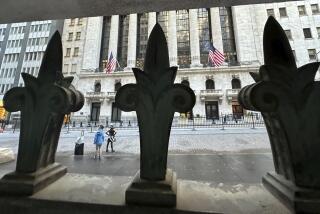What could happen if the U.S. defaults?
NEW YORK – The prospect of a U.S. debt default has unnerved investors, corporate executives and foreign leaders.
What’s so troubling about Congress failing to raise the nation’s debt ceiling by Thursday? Here are basic facts about the debt ceiling and the potential consequences of a default.
What is the debt ceiling?
The debt ceiling is a borrowing limit, similar to the spending cap on a credit card.
It places a lid on how much the United States can borrow by selling Treasury bonds. The federal government routinely spends more than it takes in through taxes and other income, forcing the Treasury Department to sell bonds to finance routine governmental operations.
Failure to raise the debt ceiling could prevent the government from having enough money to pay its bills.
Creditors such as Social Security recipients and Treasury-bond investors would be paid eventually. But failing to make timely interest payments to bondholders would be a default.
Why is the debt ceiling issue so important?
The ability of the U.S. to pay its debts on time is a critical symbol of the nation’s financial sturdiness and reliability.
Treasury bonds have long been considered “risk-free,” a testament to the strength of the U.S. economy and the belief that, no matter what, the United States would make good on its IOUs.
T-bonds are a building block of the global financial system and a benchmark for transactions across the globe. For example, home mortgage rates closely track the yield on the 10-year Treasury note.
“Treasuries are the basic bedrock of the financial system,” said Nicholas Colas, chief market strategist at ConvergEx Group, a brokerage in New York. “The risk-free rate is the most important notion in public finance, because everything builds up off of that.”
What happens if there’s no deal by Thursday?
The government actually breached its debt ceiling in May. Since then, the Treasury Department has used accounting contortions to remain below the limit.
But it can’t keep that up forever. The department warns that it will run out of borrowing authority on Thursday.
That doesn’t necessarily mean the U.S. would default right away. Bills do not come due every day. It’s not clear exactly which day the U.S. would be unable to meet its obligations.
What happens if the U.S. government defaults?
Wall Street analysts predict a major sell-off in stocks and Treasury bonds – in part because it would scare investors who are uncertain about what would happen and make preemptive moves to protect themselves.
“It would put fear throughout the market and what would happen is you’d see an avalanche of selling,” said Quincy Krosby, market strategist for Prudential Financial. “And selling begets more selling.”
Some large institutional investors may not be able to hold bonds that are in default, so they could be forced to unload their massive holdings. Goldman Sachs analysts see a large-scale forced selling of Treasuries as a relatively low risk, however.
“Many investment mandates allow investment in Treasury debt or sovereign debt generally, without regard to the rating of that debt, so a downgrade should not generally affect the ability of major holders to continue holding securities,” Goldman analysts said in an Oct. 5 note.
The bigger concern may be an exodus from money-market funds, which often trade in short-term Treasury bonds. Investors worry that defaulted Treasuries could prompt money-market funds to sell.
What would happen to the United States’ credit rating and its borrowing costs?
A U.S. default would presumably lead to downgrade by credit ratings firms. Standard & Poor’s downgraded the U.S. credit rating two years ago during the last furor over the debt ceiling.
The immediate impact to the U.S. could be higher borrowing costs to fund government operations, because investors would demand higher interest payments to compensate them for newly demonstrated risk.
In other words, a default could exacerbate the U.S. debt.
A downgrade could also affect bonds issued by other government agencies at the state and local level.
Kenneth Bentsen Jr., president of the Securities Industry and Financial Markets Assn., a Wall Street trade group, told Congress last week a default would “trigger a series of events which inevitably would lead to American taxpayers paying more to finance our debt” and could imperil “our fragile economic recovery.”
What kind of market turmoil might we see?
When the U.S. last flirted with a default two years, the stock market fell into a 17% correction. The Dow Jones industrial average sank 634 points on the day that S&P issued its downgrade.
Some worry about a credit crunch, particularly in short-term financing.
Already, there are signs of anxiety growing in a corner of the financial world known as the repo market. Repo is short for repurchase agreement, and this corner of finance allows companies to pay for short-term capital needs. U.S. Treasury bonds are often used as collateral.
Last week, yields on one-month U.S. Treasury bonds jumped as investors grew nervous about whether the government would meet its looming obligations.
Yields, a measure of perceived risk, jumped to 0.33% Tuesday, more than double the 0.16% the previous day. One-month Treasury yields have retreated but remain elevated around 0.24% as of early Tuesday.
Yields on three- and six-month Treasury bonds, meanwhile, jumped Tuesday as dealmakers in Washington considered a deal that would raise the debt ceiling for six weeks, according to Tradeweb.
In the case of default, rising interest rates could bleed into rates paid by consumers, such as for mortgages.
Where would investors flee for safety?
When the U.S. credit rating was downgraded, investors nonetheless plowed into Treasury bonds, pushing down the country’s borrowing costs. But this time Europe is no longer in recession. And if the U.S. defaulted, Treasuries may no longer be such a safe haven.
Investors might instead favor bonds issued by other countries with similarly strong credit ratings, analysts said. Or they could pile into bank accounts that are insured by the Federal Deposit Insurance Corp.
More to Read
Inside the business of entertainment
The Wide Shot brings you news, analysis and insights on everything from streaming wars to production — and what it all means for the future.
You may occasionally receive promotional content from the Los Angeles Times.










